![]()
![]()
![]()
Use LEFT and RIGHT arrow keys to navigate between flashcards;
Use UP and DOWN arrow keys to flip the card;
H to show hint;
A reads text to speech;
47 Cards in this Set
- Front
- Back
- 3rd side (hint)
|
KNEE JOINT |
tibiofemoral articulation |
|
|
|
KNEE MOTION |
1. flexion 2. extension 3. external rotation 4. internal rotation |
|
|
|
1. FLEXION |
- motion of tibia in sagittal plane - angle b.t tibia & femur relative to anterior aspect of body becomes greater |
|
|
|
2. EXTENSION |
- motion of tibia in sagittal plane
- angle b.t. tibia & femur relative to anterior aspect of body becomes smaller |
|
|
|
3. EXTERNAL ROTATION |
- motion of tibia in transverse plane about longitudinal axis
- anterior aspect of tibia moves toward lateral aspect of body |
|
|
|
4. INTERNAL ROTATION |
- motion of tibia in transverse plane about longitudinal axis - anterior aspect of tibia moves toward midline |
|
|
|
KNEE BONES FROM ANTERIOR ASPECT |
1. diaphysis of femur 2. epiphysis of femur 3. medial condyle of femur 4. fibula 5. tibia |
|
|
|
1. DIAPHYSIS OF FEMUR |
- long narrow shaft - very dense - compact or lamellar bone |
shaft |
|
|
2. EPIPHYSIS OF FEMUR |
- on distal and proximal aspects - larger cross-sectional area - cancellous bone - enhances stability b.t articular bones |
ends |
|
|
3. MEDIAL CONDYLE OF FEMUR |
- oblong ball of bone on medial aspect of femur within the distal epiphysis |
ball |
|
|
4. FIBULA |
- articulates with tibia @ tibiofibular articulation - fibula doesn't articulate w. femur |
little bone |
|
|
5. TIBIA |
- primary weight bearing bone - articular bone of the tibiofemoral articulation |
big bone |
|
|
KNEE BONES FROM POSTERIOR ASPECT |
1. hyaline cartilage 2. intercondylar fossa |
|
|
|
1. HYALINE CARTILAGE |
- shiny white substance - on medial & lateral condyles of femur - articular cartilage - limits friction b.t. articular bones |
|
|
|
2. INTERCONDYLAR FOSSA |
- distal aspect of femur on posterior aspect - large gap b.t. medial & lateral condyles - important because: - large gap on tibial plateau b.t. medial & lateral tibial articular facets |
|
|
|
KNEE BONES FROM LATERAL ASPECT |
1. shape of articular aspect of femur 2. shape of articular aspect of tibia 3. movements of bones |
|
|
|
1. SHAPE OF ARTICULAR ASPECT OF FEMUR |
- convex - femur = more stable bone in this articulation |
|
|
|
2. SHAPE OF ARTICULAR ASPECT OF TIBIA |
- concave - tibia = more mobile bone in articulation |
|
|
|
3. MOVEMENTS OF BONES |
tibia glides on femur... EXTEND KNEE: tibia moves towards anterior aspect of femur in sagittal plane FLEX KNEE: tibia moves towards posterior aspect of femur in sagittal plane INTERNAL/EXTERNAL ROTATION: tibia rotates on femur in transverse plane about longitudinal axis |
|
|
|
LATERAL LIGAMENTS OF KNEE |
1. lateral collateral ligament 2. lateral meniscus 3. coronary ligament |
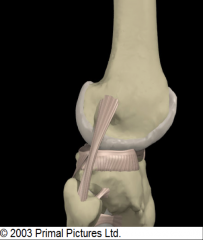
|
|
|
1. LATERAL COLLATERAL LIGAMENT |
- prevents excessive varus motion *like if someone kicked you in medial aspect of knee - round and thin ligament |
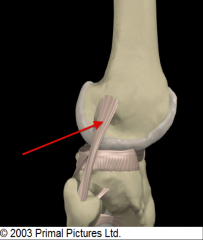
|
|
|
2. LATERAL MENISCUS |
- fibrocartilage disk - dissipates compressive forces b.t. lateral femoral condyle & lateral tibial articular facet - "torn cartilage" - but medial meniscus tears more often |
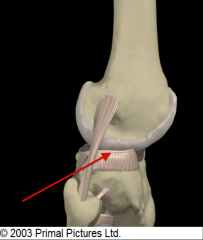
|
|
|
3. CORONARY LIGAMENT |
- attaches lateral meniscus to tibial plateau - oriented vertically |
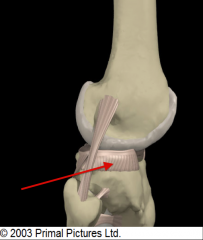
|
|
|
SUPERIOR VIEW OF TIBIAL PLATEAU: MEDIAL v. LATERAL |
- tibial plateau articulates w. superior & posterior aspect of medial & lateral condyles medial v. lateral: 1. articular facet surface area 2. meniscus diameter 3. meniscus thickness |
|
|
|
1. SURFACE AREA OF ARTICULAR FACET |
medial > lateral |
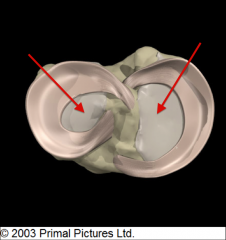
|
|
|
2. MENISCUS DIAMETER |
medial > lateral |
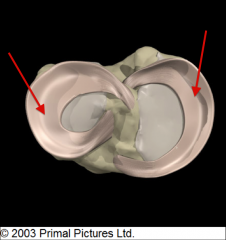
|
|
|
3. MENISCUS THICKNESS & 2 IMPORTANT FUNCTIONS |
peripheral = thicker center = thinner SHAPE FUNCTIONS TO: 1. increase congruency b.t. femur & tibia 2. allows synovium to pump around articular structures during bone motion |
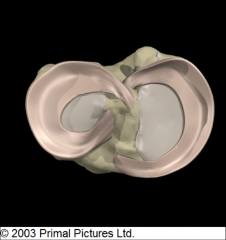
|
|
|
OVERLYING MUSCULATURE ON LATERAL KNEE |
1. IT-band A. tensor fascia latae 2. biceps femoris |
|
|
|
1. ILIOTIBIAL BAND (IT-BAND) |
- dynamic stabilizer of LCL |
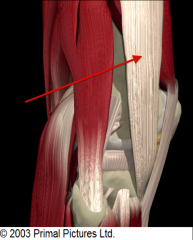
|
|
|
1a. TENSOR FASCIA LATAE |
- contractile unit of IT-band - contracts + generates compressive force applied to knee - stimulating this muscle produces varus force & protects LCL - inserts into anterior fibers of IT-band |
|
|
|
2. BICEPS FEMORIS |
- inserts into proximal head of fibula |
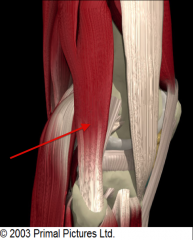
|
|
|
MEDIAL LIGAMENTS OF KNEE |
1. medial collateral ligament |
|
|
|
1. MEDIAL COLLATERAL LIGAMENT |
- prevents valgus motion *generated by being hit on lateral aspect of knee - causes medial joint space to increase - thick, broad, long - disruption = cant be repaired |
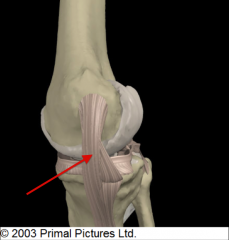
|
|
|
OVERLYING MUSCULATURE ON MEDIAL KNEE |
pes anserinus: 1. sartorius 2. gracilis 3. semitendinosus = dynamic stabilizers for MCL |

|
|
|
POSTERIOR LIGAMENTS OF KNEE |
1. posterior cruciate ligament |
|
|
|
1. POSTERIOR CRUCIATE LIGAMENT |
- prevents excessive posterior translation of tibia on femur *AKA keeps knee from moving backwards on femur - origin = anterior & medial aspect of medial condyle - inserts: intercondylar area of posterior tibial plateau - strongest ligament in knee - when we flex knee - posterior trans of tibia on knee |
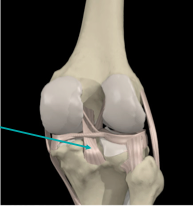
|
|
|
OVERLYING MUSCULATURE ON POSTERIOR KNEE |
- dynamic stabilizers for ACL 1. biceps femoris 2. semitendinosus 3. semimembranosus |
|
|
|
1. BICEPS FEMORIS (independent & with...) 2. SEMITENDINOSUS 3. SEMIMEMBRANOSUS |
BICEPS FEMORIS: - on posterior & lateral knee - contract... INDEPENDENTLY: - dynamic stabilizer for LCL W. SEMI'S: - dynamic stabilizer for ACL |
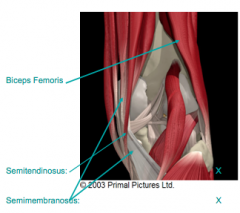
|
|
|
ANTERIOR LIGAMENTS OF KNEE |
1. anterior cruciate ligament |
|
|
|
1. ANTERIOR CRUCIATE LIGAMENT
|
- prevents excessive anterior translation of tibia on femur *AKA keeps knee from moving forward on femur - origin = posterior & medial aspect of lateral condyle of femur - inserts = medial aspect of intercondylar area of anterior tibial plateau - smaller than PCL - takes 1/2 of the force needed to disrupt PCL to disrupt ACL |
|
|
|
ACL MECHANISMS OF INJURY |
1. HYPEREXTENSION: 2. EXCESSIVE TIBIAL ROTATIN - when ruptured - cant heal - cause proximal & distal segments separate - wound edges "unravel" - ACL disruption thus requires reconstruction, won't heal |
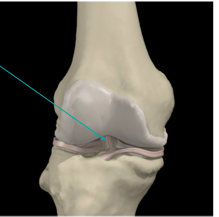
|
|
|
OVERLYING MUSCULATURE ON ANTERIOR KNEE |
1. patella 2. quadriceps tendon 3. medial patellar retinaculum 4. lateral patellar retinaculum 5. patellar ligament |
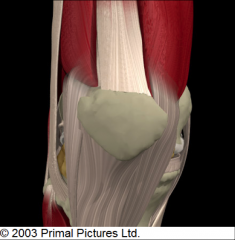
|
|
|
1. PATELLA |
- AKA kneecap - largest sesamoid bone in body sesamoid bone = one found within tendon |

|
|
|
2. QUADRICEPS TENDON |
- connects 4 quad muscles w. patella |
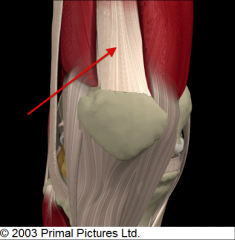
|
|
|
3. MEDIAL PATELLAR RETINACULUM |
- ligamentous-like structure - stabilizes patella against excessive lateral movement of patella on femur |
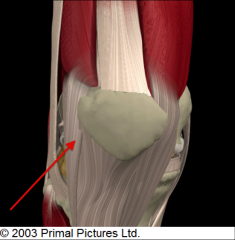
|
|
|
4. LATERAL PATELLAR RETINACULUM |
- ligamentous-like structure - stabilizes patella against excessive medial movement of patella on femur |
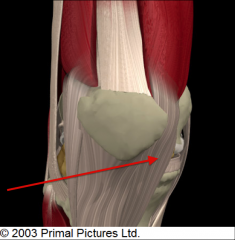
|
|
|
5. PATELLAR LIGAMENT |
- falls b.t. medial & lateral patellar retinaculum - attaches inferior pole of patella to tibial tuberosity |
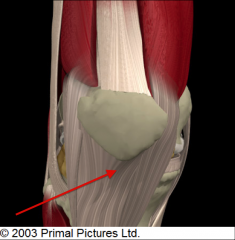
|

